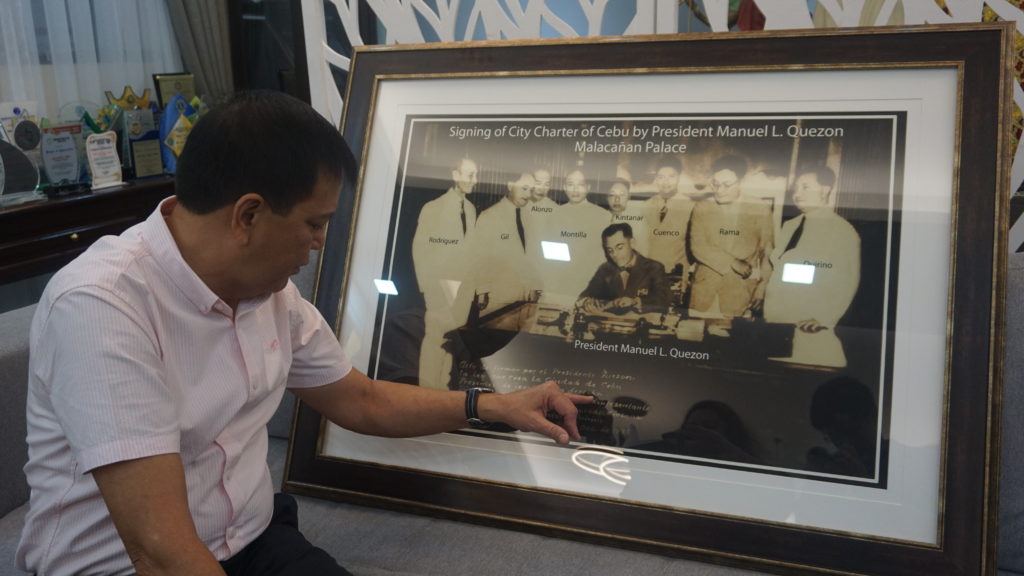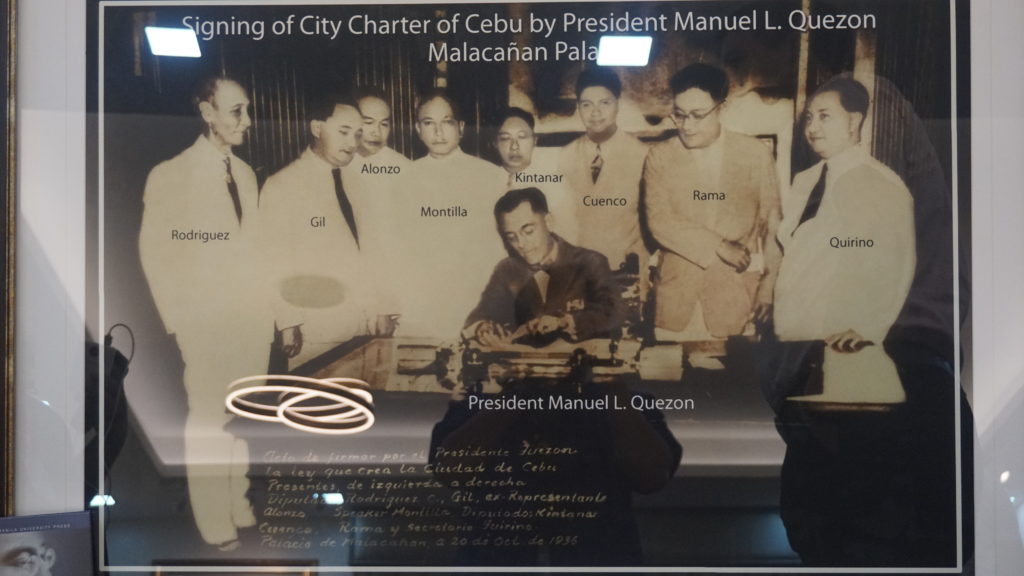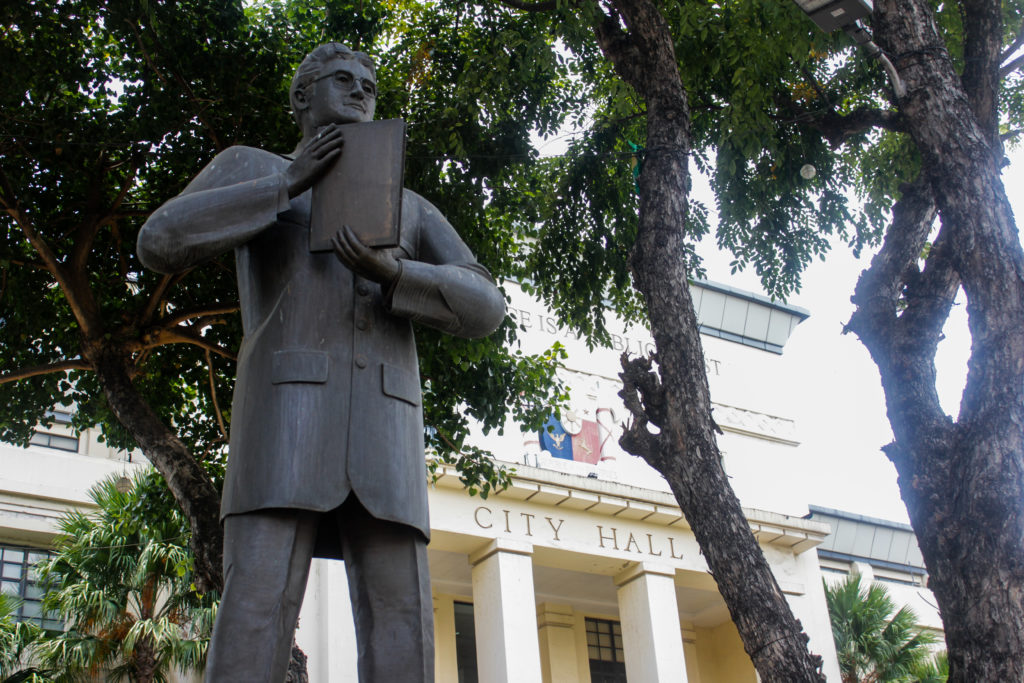The crowning of Cebu City, the Queen City of the South

Cebu City Vice Mayor reads a message written in a picture that depicts the signing of Cebu as a Charter City on 1936. | Raul Tabanao
CEBU CITY, Philippines — The year was 1936 when then-Congressman Vicente Rama, more known to his people as the Don Vicente Rama, was teased in Congress why the bustling economic leader of the country’s mid-southern islands remained a municipality.
Sugbo or Cebu was the seat of power of the provincial government and was the largest municipality in the province at that time.
The previously separate municipalities of Pardo, Mabolo, Talamban, Banilad, and San Nicolas all lost their municipality status in 1934 and simply melted into what was then the municipality of Cebu as its foremost barangays.
In his letters to local officials as written in Rama’s memorial book, the politician complained of how the other legislators rubbed on his face the charter of smaller and less economically developing municipalities of Zamboanga, Iloilo, and Baguio as cities, but Rama’s own beloved island in the south had remained a municipality.
It was then that the Father of Cebu City’s Charter envisioned Cebu becoming a chartered city, autonomous from the provincial government, and claiming its rightful name as the “Queen City of the South.”

A photo that shows the declaration of Cebu as a City
The Cebu City Charter
Cebu City’s charter did not come easy for Don Vicente, as he lodged the bill in Congress in August 1936, he met “astounding” opposition from prominent families from the province of Cebu and their congressional allies.
Don Vicente’s grandson, the former mayor now Vice Mayor of Cebu City, Michael “Mike” Rama, retold the story to CDN Digital, how the Congress burned the night oil simply to debate the autonomy of Cebu.
“Wala akoy tuyo nitinguha nga tinago pagpasaka ko sa amaong balaodnon. Mao diay ako giapas nga ang Sugbo nga mahilumbay sa mga syudad sa Manila ug Baguio nga adunay kaugalingong charter nga tungod niini nagmauswagon,” said Don Vicente as read by Vice Mayor Mike through a chapter on Don Vicente’s memorial book.
(I do not have any ulterior motives or hidden agenda in my pushing for the bill. I want Cebu to become at par with Manila and Baguio, which have their own charters making them progressive.)
Mike said that the opposition was brought by the political divide between the provincial government and the autonomy-seeking municipality of Cebu.
Some politicians refuse to let go of Cebu for it was the most economically developed city in the province and held the population that could make or break the gubernatorial race.
“There was political superiority. An entire island run by a governor. Cebu was very influential, it could dictate who will become governor,” said Mike.
In the evening of October 2, 1936, the debate went on for more than a day in the National Assembly, as congressmen from Cebu’s other districts and even representatives of other provinces questioned the need for Cebu’s charter.
It was 11 p.m. when Commonwealth President Manuel Quezon put his foot down and said that Cebu would have its charter. In Don Vicente’s memorial book, he said, the President became too tired of the debate and simply wanted to rest.
On October 20, 1936, Quezon signed the law making Cebu town a chartered city. On February 24, 1937, the city was officially inaugurated paving way to the economic boom that would last until the present day.
For historian, Doctor Jobers Bersales, there should not have been much debate on whether the town Cebu deserved the cityhood because in 1936, Cebu had already boasted of more than 300,000 population.
Its economic growth was second only to the capital city of Manila and with at least 300 square kilometers of territory, its candidacy for cityhood was unquestionable.
“Cebu cityhood is a special case. It’s a signal that from a town, it could grow further,” said Bersales.

The Cebu City Hall | CDN Digital File Photo
Lack of land, continued economic growth
The most immediate problem for Cebu City after its inauguration in 1937 was although it held jurisdiction over at least 300 square kilometers of land, it did not hold ownership to most of it.
As the seat of the province’s power, most of the city’s lands were owned by the provincial government.
It was then that Don Vicente along with the newly elected officials of Cebu City faced the problem of the lack of land ownership over the city’s jurisdiction.
Up to the present day, the swapping of land between the provincial government and the city government continues in the highly debated 93-1 land swap deal.
This problem paved way for the reclaiming of portions of the sea in the north now known as the North Reclamation Area, which was the brainchild of Sergio “Serging” Osmeña Jr., the son of President Don Sergio Osmeña.
It was followed by the reclamation of the South Road Properties (SRP), where the city took a P4.65 billion loan in 1995 which the city government continued to pay for up to the present day.
Vice Mayor Mike said that these were the hurdles the city faced in its 83 years of being a charter, yet it had continued to remain on the top as the economic queen city outside of Metro Manila.
Currently, Cebu City is the 4th richest city in the country and the richest city outside the National Capital Region.
With its over 900,000 population, Cebu City has one of the largest workforce in the country, which is seen as the reason the Business Process Outsourcing (BPO) industry has rapidly risen in the past two decades with the establishment of economic centers such as the Cebu IT Park in Barangay Apas and the Cebu Business Park in Barangay Hipodromo.
The SRP is also a rising economic center with a total of P500 billion investments pouring into the reclaimed properties by developer giants such as the SM-Ayala Consortium, Filinvest, and the Gokongwei-led Universal Hotel and Resorts Incorporated (UHRI).
Mike said that if Don Vicente could see Cebu City today, he would have been proud of what it had become.

The statue of Vicente Rama is seen outside the Cebu City Hall | Gerard Francisco
ññ
The seat for culture
Cebu City is not only a treasure pot for business and commerce, it is also uniquely attached to its history and culture.
Doctor Bersales said that even before it became chartered, Cebu town was already unique, with the influx of people from nearby Visayan provinces and islands, and entry of international trade through its massive ports.
The city is a melting pot for culture, yet it has remained proud of its distinct Cebuano culture such as its language, which in 1930s was actually the predominant language spoken by most Filipinos in Visayas and Mindanao.
It was only put aside for Tagalog to be the national language as Manuel Quezon was a Tagalog-speaking president.
Bersales said that until now, Cebuanos had taken pride on being culturally different from the country’s capital.
“Kung pangutan-on nimo ang Cebuano in Tagalog, tubagon ka in English. Bisan atong Tagalog naay accent. (If you ask a Cebuano in Tagalog, you will be answered to in English. Even our Tagalog has an accent),” said Bersales.
The cityhood of Cebu strengthened this pride of Cebuanos over its language and its culture, and in spite of economic growth, it has remained to be a heritage city, where history and culture were preserved.
Masterplan for the city’s future
Disclaimer: The comments uploaded on this site do not necessarily represent or reflect the views of management and owner of Cebudailynews. We reserve the right to exclude comments that we deem to be inconsistent with our editorial standards.
